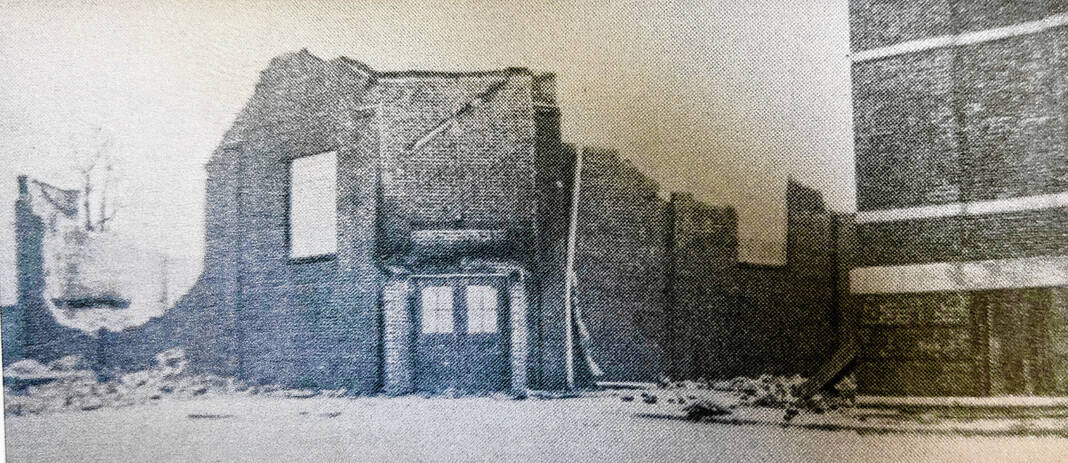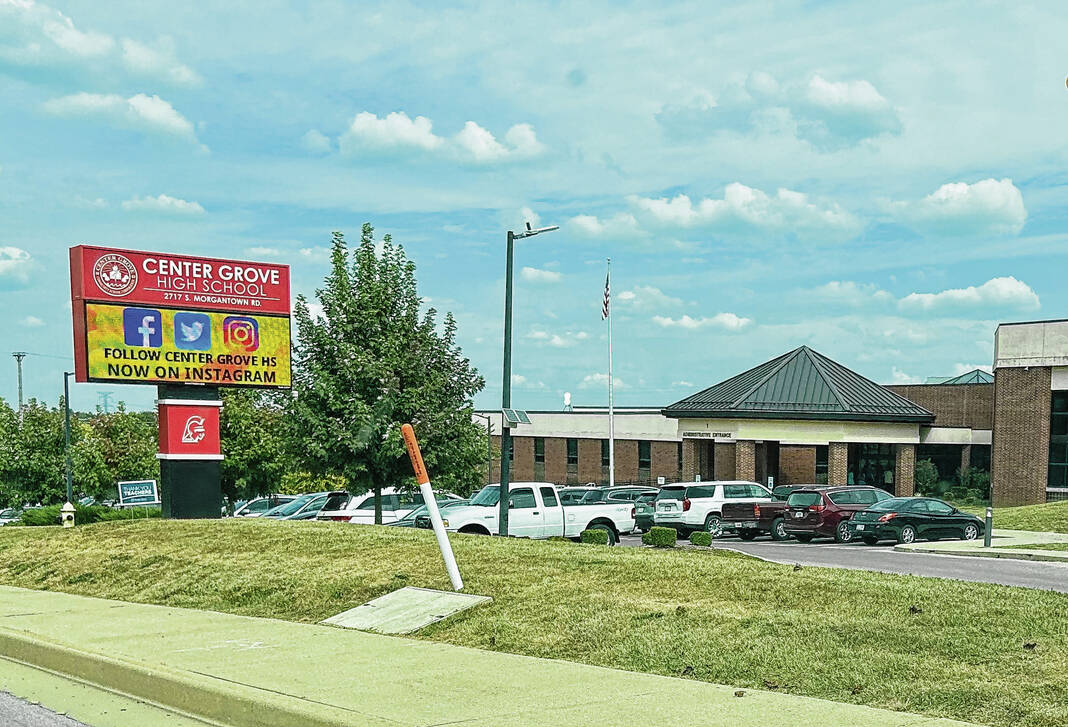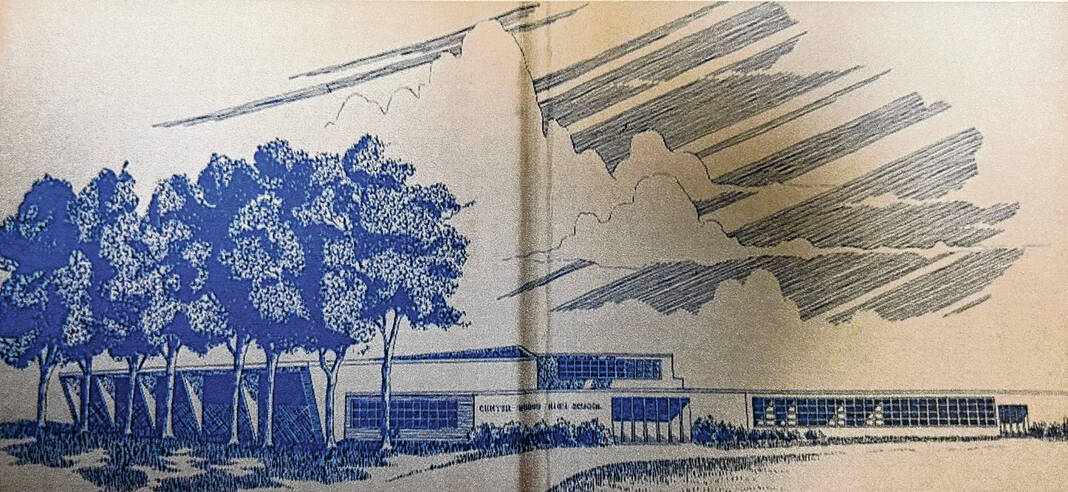Before anyone knew it, the school was engulfed in flame.
Three men driving near Center Grove High School noticed the strange, yellow glow in the late hours of Oct. 31, 1952. They found the school on fire, with both the main school building ablaze and spreading to the gymnasium. Witnesses say the flames shot 150 feet into the air. Even as firefighters worked all night long, there was not much they could do.
The fire burned the school to the ground, leaving students, teachers and the community in flux. But the tragedy proved to be a critical point in Center Grove’s history.
“The theme that developed after the fire was — how do we continue education? We have these kids without a school, how are we going to keep that going?” said John Frank, a historian who taught social studies at Center Grove High School for 29 years. “Center Grove has had three different high school buildings, but they’ve all been in the same place — at the top of that hill. That continuity is important to people.”
More than 70 years after the fire, the impact can be seen throughout the current school district and the White River Township area.
A group of local historians and Center Grove alumni, led by Frank, have worked to catalog the history of the 1952 fire. Their research, culled from interviews with living witnesses, official accounts and other records, will hopefully give valuable insight into the school’s past for current and future students.
“I love the community history, and it needs to be retained,” said Jeff Beck, a member of Center Grove’s Class of 1967 who helped Frank with the project.
For many years, Center Grove alumni have worked together on various projects to bring pieces of the school’s history to life. They have gathered mementos and artifacts from families across the area, showcasing generations of students who have called themselves Trojans.
A glass display case in the current Center Grove High School is filled with photographs, yearbooks, letter jackets and other items. Recently, a replica of the Trojan Horse mascot from the 1940s and 1960s and ’70s has been added to the display.
All of it is to help students today better understand the traditions of the past, Beck said. The 1952 fire research was an extension of the Trojan Horse project.
“John and I had both fallen in love with Center Grove history, and when we finished the mascot,” Beck said. “It’s important to both of us to keep the students abreast of their history.”
To pull the story together, Frank combed through a variety of different sources, from newspapers in Franklin, Indianapolis, Greenfield and others, as well as Center Grove yearbooks.
He also interviewed alumni and local residents who were alive at the time who could offer some perspective.
“The sources are largely newspaper, but there are some alumni and other people who experienced it, as well as some other miscellaneous sources,” he said. “This is taking all kinds of information from different places and putting it into one comprehensive story.”
The story of the fire is impossible to tell without delving into a longtime White River Township tradition that preceded it: the Halloween Carnival. Between 1919 and 1952, the carnival was a high school fundraiser most years. Nearly the entire community came out to participate — children, parents and other adults.
About 750 people attended the event in 1952. Prizes that night were awarded for funniest, ugliest, best couple, most original and prettiest costumes, according to the Johnson County News, a paper covering the county at the time.
The Halloween Carnival ended at 10 p.m. on Oct. 31, 1952, and the final person to leave was gone by 10:45 p.m. It is estimated the fire started between 11 p.m. Oct. 31 and 12:30 a.m. Nov. 1. The first people reported to observe it were three men — Earl Russell, Joe Godfrey and Clyde Teverbaugh — who were driving on State Road 37 when they saw the yellowish glow and strange light in the east. They followed it to find the school on fire.
The three men woke up a nearby resident, who called the Greenwood Fire Department. Firefighters responded by 1 a.m. In the end, both the main school building and the gymnasium were lost. But firefighters were able to save surrounding structures, such as the farm shop and a recently opened elementary school.
One of the more interesting stories from the fire surrounded money made during the Halloween Carnival. The significant amount raised during the event had been stored in two boxes in the basement of school after the carnival by Ratliff, the principal of the high school.
Rumors starting floating that the fire had been a coverup for someone taking the funds.
“The county prosecutor then had an investigation, and a week later, they issued a report saying it was wiring that had caused the fire,” Frank said. “And, the two boxes had been found. They were taken to the National Bank of Greenwood. The silver coins had melted together but the paper was charred, but was sent to the Treasury for replacement. Some of the nickels and pennies survived, and we have some of them on display up at the high school.”
The White River Township community was in disarray following the fire. School was suspended for all Center Grove students the week following the blaze.
Center Grove’s basketball team had been scheduled to play a game against Whiteland on Nov. 1, but all of their equipment had been destroyed. By chance, the team had brought home their home white jerseys. So they decided to play, moving the game to Whiteland.
The emotional game ended in a 48-46 overtime win for the Trojans. Norm Hyatt, a Center Grove Class of 1953 graduate and leading scorer on the basketball team at that time, scored 26 points in the win.
“I do remember a rumor floating around that if we lost the game with Whiteland, then the season may be canceled. Jack White and myself were the only seniors on the team and we weren’t about to quit. The team as a whole played very well that night,” Hyatt said in an interview for the project.
More important were the questions on what to do next. Local residents debated if the students should be kept together while rebuilding, or if they should be sent to other schools around the county. In the end, Center Grove students remained together, shuffling to other school buildings within the district.
Schools throughout Johnson County, including Franklin College, offered equipment to help classes go on. With the help of the state superintendent of public schools, textbook publishers replaced books that had been lost. Businesses and organizations gave financial and material support, Frank said.
Community leaders also stressed over how to rebuild a high school. Estimates were that they needed $500,000 to construct a new building, though by the time work started on it, that figure rose to $625,000.
In the end, White River Township residents formed a holding corporation, with community members buying shares to help finance the project. Construction started on a new high school on Nov. 16, 1953, and a dedication ceremony was held on Dec. 14, 1954.
On Jan. 16, 1955, the Indianapolis News ran a column about the new schools. “Today this modernistic, completely equipped academic hall is in full operation, a monument to no single community but to the ambition and work of an entire township that has a fierce pride in an ability to provide for itself,” the article read.
Most importantly to the people of White River Township and to the people who love Center Grove, the decision was made to keep the school on the hill where the old building had been. A high school had stood at that spot since 1884, and it remains there today.
“With the grace of God, we stayed on that hill called Center Grove,” Hyatt said in an email to Frank.
Working with Ryan Jones, an art and technology teacher at the high school, as well as Center Grove students, Frank has organized a website where the full report will be posted online. A QR code is going to be placed at the high school inside the history display case to take people to the website with the research project.
As Center Grove grows and expands, and as new people move into the district, it’s important that people understand the heritage that led the school to this point, Frank said.
“The vast majority of people living in White River Township aren’t from the township. That’s great to have growth, but at the same time, if they go to the school or even if they just live around it, and they don’t have an understanding of the long past,” Frank said.









